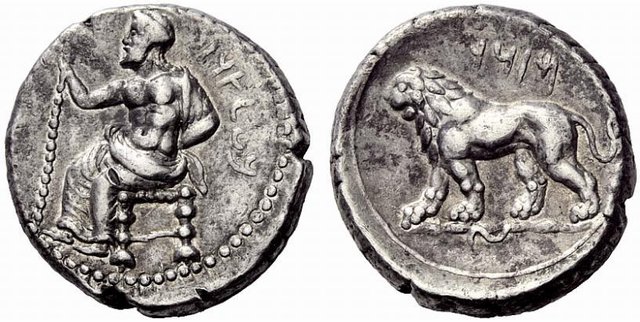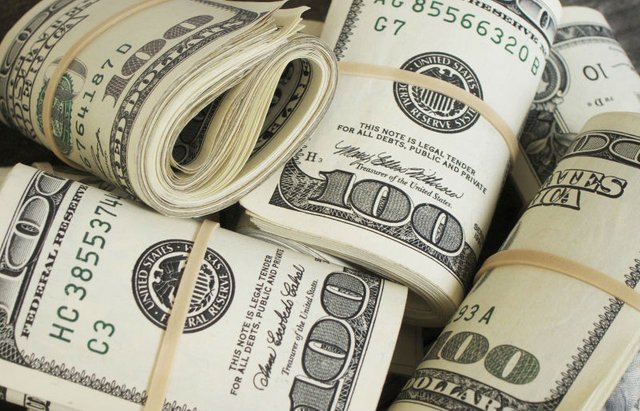When Did Humans Start Using Money Instead Of Trading Items? Did You Ever Wonder?
A long time ago, people did not buy or sell with money; let alone with Steem or Bitcoin ;-) Instead they traded one thing for another to get what they wanted or needed. This exchange of goods or services is called barter.
At the beginning this was sufficient, but with the evolution of societies, certain needs made the creation of a more stable and more efficient way of trading imperative. Many cultures around the world eventually developed the use of money whose value was based on the value of the material from which it was made.
This type of money is known as “specie money” and its value is guaranteed by the precious metal it contains. The first coins were originally manufactured from copper and then iron because these were strong materials used to make weapons. The monetary value of currencies was based on the value of the metal from which they were made.
Coins were convenient because they could be counted rather than weighed. Coins were a trusted and efficient medium of exchange because they helped to significantly boost trade in the ancient world. The first type of coin was used around 3000 BC in Mesopotamia and was called siglos or shekel. The shekel was an ancient unit of money and weight used to define both a specific weight of barley and equivalent amounts of materials such as bronze and copper.
The great importance of formalizing the role of money in civil society was even mentioned in Hammurabi‘s law code created around 1760 BC. Mesopotamian civilization developed a large-scale economy based on commodity money. The Babylonians and their neighboring city-states later developed the earliest system of economics as we think of it today, in terms of rules on debt, legal contracts, and law codes relating to business practices and private property.
In 700 BC the Greek king Pheidon of Argos was the first ruler known to have officially set standards of weight and money and to have coins made from a rather useless and decorative metal like silver rather than of iron. King Pheidon coined silver coins in Aegina, in the temple of the goddess of wisdom and war Athena Aphaia, and developed currencies with turtles on them. (Turtles are a symbol of capitalism today.)
Turtle currencies were accepted and widely used as an international medium of exchange until the days of the Peloponnesian War, when the Athenian drachma replaced them.According to Herodotus, the first gold coins of the Grecian age were struck in Lydia, in Asia Minor, around 700 BC, under King Croesus, but it was not until 390 BC when King Philip II of Macedonia issued the first gold currencies.
Source. Illustration created by Mark Cartwright
The Lydian coins were made of a weighed amount of precious metal and were stamped with the image of a lion. Even in ancient times the excessive importance given to money was recorded by Livy, who mentions a temple that was built and consecrated to the worship of Hera Monitas, hence the English “money,” in Rome around 413 BC. The temple contained the mint of Rome for four centuries.
The First Paper Money in History
The first paper money or banknotes were first used in China during the Song Dynasty, between 600 and 1455. These banknotes, known as Jiaozi, had been used since the seventh century AD. In Europe the first banknotes were issued by Stockholms Banco in 1661 and used alongside coins. it did not work well, and had to be stopped because the banks kept running out of coins to pay on the notes.
But in the 1690s, the Massachusetts Bay Colony printed paper money and here the use became more common. Using coins as money based on the value of the material from which they are made eventually led to representative money. This happened because gold and silver merchants or banks began to issue receipts to depositors redeemable for cash value, which were tabulated.
Ultimately, these receipts were widely accepted as payment and began to be used as money. The convenience of transactions provided by the issuance of banknotes allowed notes used for exchange to become a widespread and commonly accepted business practice. This monetary system, where the means of exchange is paper that can be converted into preset, fixed quantities of gold, replaced the use of gold coins as money between the seventeenth and nineteenth centuries in Europe.
Fiat Money Enters Our Lives
In the early twentieth century almost all countries adopted this system for which certificates were issued, and there was a predetermined amount of gold for redemption. After World War II and the Bretton Woods Conference, most countries adopted “Fiat money,” whose value was determined according to the US dollar. In turn, the US dollar was determined by reference to gold.
In 1971, the US government ended the convertibility of the dollar into gold, leading many countries to follow its example, and the majority of the money worldwide stopped being backed by gold reserves.
Money, in whatever form it is found, has proved a necessary evil from its creation, and there is no more apt definition of its origin than Aristotle’s: “When the inhabitants of one country became more dependent on those of another, and they imported what they needed, and exported what they had too much of, money necessarily came into use.”
The article was written by me and originally published at my blog theo-cracy.com and Ancient OriginsBonus Facts:
- The earliest places of storage were thought to be money box containers similar in construction to a beehive, akin to the Mycenaean tombs of 1550–1500 BC.
- The word used by Thucydides for money is chremata, translated in some contexts as “goods” or “property,” although with a possibly wider-ranging application, having a definite meaning of “valuable things.”
- According to myth, Zeus punished Hera and tied her with a gold chain between heaven and Earth. Hera, with the help of Hephaistos, broke the gold chain and was set free. It is said that all the gold on Earth comes from the pieces of this gold chain, which fell from the sky.
- According to Aristotle, King Pheidon of Argos devoted some of the iron coins that were left (they were actually iron bars) to the temple of Hera.
- Although gold and silver were commonly used to mint coins, other metals were also used. For instance, ancient Sparta minted coins from iron to discourage its citizens from engaging in foreign trade.
- “Fiat money” derives from the Latin fiat, which means “let it be done” or “it shall be.” This type of money has been defined as currency that derives its value from government regulation or law.
Sources:
Barter, Bills and Banknotes: The 5,000 Year History of Money




"the first banknotes were issued by Stockholms Banco in 1661 and used alongside coins. it did not work well, and had to be stopped because the banks kept running out of coins to pay on the notes."
HaHa. You've sure condensed the world's oldest con game and one of the most insidious destroyers of human values into that short sentence! I speak of fractional reserve banking.
That's true, but I think the greatest con-artist in history is Hephaestus by far. He was the one who "unintentionally" (not a good guard) gave fire to mankind and from what I found out while doing research for this article, he helped Hera to escape and thus give humans gold.
If you think about it, from the day man relied on gold (money) and started eating his steak medium well (accompanied with fries), he became too greedy and soft, while humanity was doomed to become the lazy mess it is today :P
Well then, since the cat is out of the bag and we now have both fire and money, perhaps we need heed Garth:
That would be half a chicken man. Nice subject bro.
hahaha, I see that video went viral!!!
Thanks, mate. I really appreciate you and your support :)))
I love history. Good read. Sorry for spammy initial response. Please continue reading:
I listened to a podcast recently that talks about the origins of money in a tangent off of the main subject - which is supposed (?) to be aversion therapy and it’s implementation as a blockchain currency / tokenized reward system:
https://itunes.apple.com/us/podcast/love-your-work-creative-productivity-solopreneur-self/id1067860103?mt=2&i=1000406435738
It also mentions a book that explains how the federal reserve was created:
https://www.amazon.com/Creature-Jekyll-Island-Federal-Reserve/dp/0912986212
ps trivial thinking: It took me about 19 seconds (or milliseconds) into reading your post to jog my memory of where I -coincidentally- recently read (or listened to) something that seemed like dejavú of the beginning part of your post.
Ancient Origins?
Na man that pod cast lol
Aaaaaaa, my bad dawg 😜😂
Σιγά ρε ντογκ
Ειπα να το παιξω λιγο νιγκα ρε μαν ;)
h theia tzemaima den goustarei
Good read. You didn’t mention Bitcoin (and Steem of course) Bitcoin is all the things an ideal form of money should be. It’s durable and divisible; it’s verifiable and valuable. The banks and the ruling classes are terrified about its appeal, as it offers the promise of lower transaction fees than traditional online payment mechanisms and is operated by a decentralized authority, unlike government issued currencies, as we all know. 👍
Thanks for the good words and the informative comment my friend :)
Thank you. Good article, keep them coming.
Great post.I felt like I was in a history and a financial business lesson at the same time.
Thanks, mate. I guess my mission to "enlighten" was accomplished then 😎
Well,you did a great job.You covered like more than 5000 years in less than 5000 words right?
I think that is something :D
I wish everyone (especially in the Greek community) was as appreciative and καλοπροαίρετοι as you my friend. Unfortunately, jealousy and envy won't ever let the citizens of this country to progress. Sad...Thank you very much for your kind words. They mean a lot to me :)
So much deja vu to my history classes!
Gone are the days when life was this simple. Those must have been very peaceful times to be alive!
Great article.
However, we should disregard fiat and acquire crypto. :D especially STEEM.